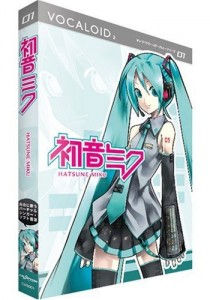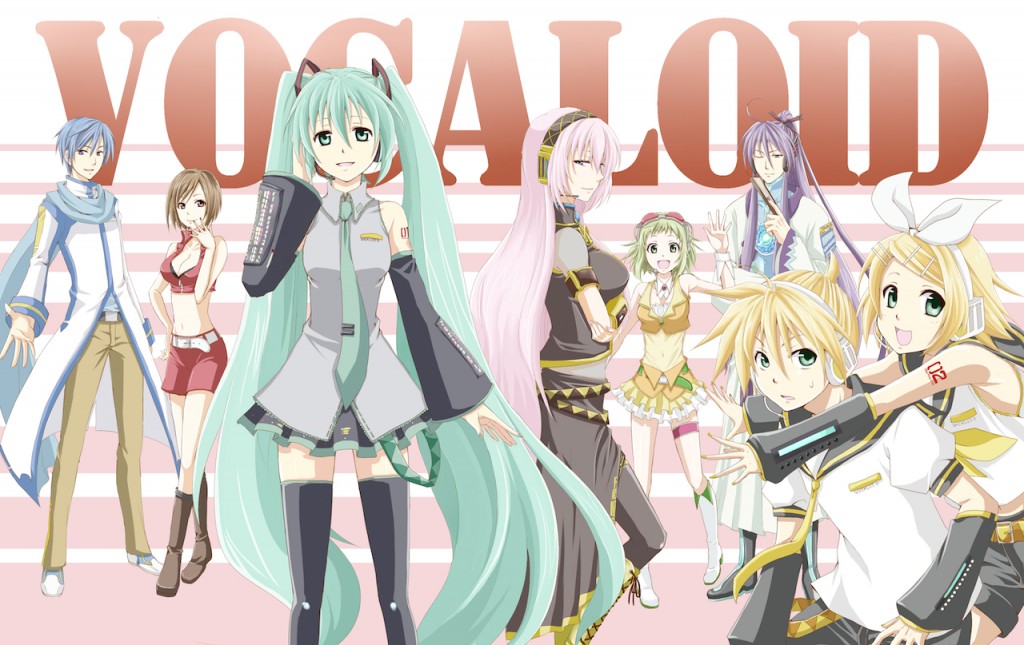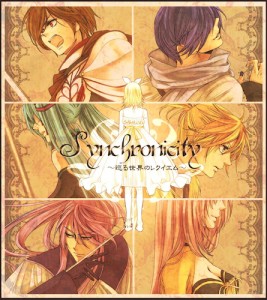Those familiar with my blog know that Wednesdays are dedicated to topics regarding creative writing. Today, I’m going to step a little outside the box (not too far, don’t worry) to share a little more of my nerdy side and talk about my newest obsession: VOCALOID. There’s a lot I could tell you about this newfound love of mine (enough to fill another series of posts, in fact), but the point of bringing it up now is simply to focus on what I consider the most interesting aspect of the fandom: creativity through collaboration. So just sit back and listen while I take you on a brief journey through this incredible musical world. Enjoy!
What is VOCALOID?
Before I answer this question, let me ask you one: have you ever heard of a Japanese singer named Hatsune Miku? If not, take a minute to listen to one of her most popular songs: “World is Mine“.
Pretty neat, huh? Now what if I told you that the singer in the video doesn’t actually exist, and what you just heard was nothing more than a computer program synthesizing a human voice? Here’s another video of her singing the same song, but this time in front of a live audience:
Yes, that’s a full house cheering for a hologram! Seriously, how cool is that?
 VOCALOID is a software from Yamaha designed to synthesize singing vocals, intended to serve as a substitute for real singers. Each package consists of a character name, a voicebank comprised of phonemes recorded by a real person, and (in most cases) a basic character design. Voice synthesizing is achieved by typing lyrics and melody into the program.
VOCALOID is a software from Yamaha designed to synthesize singing vocals, intended to serve as a substitute for real singers. Each package consists of a character name, a voicebank comprised of phonemes recorded by a real person, and (in most cases) a basic character design. Voice synthesizing is achieved by typing lyrics and melody into the program.

Hatsune Miku software for the VOCALOID2 engine
The Vocaloids started being released in 2004 with moderate commercial success, but the software exploded in popularity around 2007 when a Hatsune Miku cover of the Finnish folk song “Ievan Polkka” went viral on Nico Nico Douga (a Japanese video-sharing website similar to YouTube). Since then, VOCALOID has had a tremendous cultural impact, drawing fans from Japan and the Western world alike. To this day, Miku remains the most famous of the Vocaloids and NND plays an essential role in the collaborative creation and sharing of VOCALOID works.
Today, there are dozens of official Vocaloids available in at least six languages (mostly the original languages of Japanese and English), hundreds of fanmade voicebanks (known as UTAU), thousands of VOCALOID-related songs, and tons of derivative media ranging from video games to live concerts. There’s no doubt about it: VOCALOID is a global phenomenon.
Why is VOCALOID so popular?
Honestly, I’ve been asking myself the same question ever since I became a fan. I heard my first VOCALOID song (“World’s End Umbrella“) in 2010 through a reference from a friend, and YouTube must have remembered that because it gave me a recommendation for my second song (“Witch Hunt“) in mid-2013. The funny thing was, though I absolutely loved the latter, I had no clue yet what I was listening to. It was only in November 2013 that I really got into the fandom and started to learn more about the Vocaloids. Fast-forward half a year: I now have days’ worth of VOCALOID videos logged in my YouTube history and a playlist consisting of over 300 songs. Yeah.

The eight most popular (and my favorite) Japanese Vocaloids. In order from left to right: KAITO, MEIKO, Hatsune Miku, Megurine Luka, GUMI, Kamui Gakupo, Kagamine Len and Kagamine Rin
(Source unknown; image found on Zerochan)
So what is it about this fandom that’s kept me and countless others hooked for so long? Is it the endless assortment of awesome music? Is it the variety of characters with unique voices and personalities? Or is it the originality of the whole idea? If I had to bet on it, I’d say it’s a combination of all three, plus something extra special.
My theory is that what keeps VOCALOID going strong is the amount of creativity it takes to sustain the fandom. What starts out as a “singer in a box” becomes a character in stories told through music, a subject of visual art and a virtual presence on the stage of a sold-out concert. But what makes all this truly amazing is that the entire fanbase is built on a foundation of collaborative effort. In other words, to keep the Vocaloids “alive”, their fans usually work together.
Creativity, Collaboration, Empowerment
If there’s one song that sums up what the VOCALOID fandom is all about, it’s probably “Existence Imagination“. This is the product of the collaboration of 13 people using nine Vocaloids. The song showcases them at their best individually, in pairs and as a chorus, and the lyrics are essentially the characters happily saying they will always be there to give their voices to the creativity of their beloved songwriters. It’s all-around awesome. Hear for yourself:
The success of a VOCALOID producer is generally measured by the popularity of their uploaded works on NND, and this often relies on more than just good music. Because of this, many of the best VOCALOID videos are born from the combined effort of at least two people. One of my favorite teams of producers consists of three people: Hitoshizuku-P (music and lyrics), Yama△ (mixing) and Suzunosuke (illustration). Pretty much every project to which all three of them contribute is gold. Here’s a great example, the first video in a popular series of theirs using the famous “Vocaloid Eight”: Bad∞End∞Night.
The fun thing about VOCALOID is how interactive it is, in that it leaves about 99% to the imagination. Absolutely nothing is canon, right down to whether or not the Kagamine twins are actually related. All the developers provide is a voice and a basic character design; everything else (personalities, relationships, etc.) is left entirely up to the fans. And this opens the door to a flood of creative ideas.

The Vocaloids as they appear in the Synchronicity trilogy (illustration by Suzunosuke)
Hatsune Miku has played every role from a self-aware artificial being to a shy girl in love to a powerful demigoddess. Megurine Luka is well known for singing in both Japanese and English, in tones ranging from low and soft to high and cute. Kagamine Rin and Len play siblings in some of their videos and lovers in others. Vocaloids sing solo, in duets, in trios and in groups. They’ve covered every genre and style of music: adorable, comedy, tragedy, horror, etc. In the spirit of creativity, producers even release off-vocal versions of their music to make it possible for others to cover the same songs using different Vocaloids (or their own voices). Their program has been around for ten years now. And the music just keeps coming.
So many possibilities have been constructed around the Vocaloids that it’s easy to forget they’re each nothing more than a voice and a drawing. Fans collectively build their personalities through music and visual art to create the characters we know and love, and I believe there’s a sense of empowerment to be found in that. The developers may have created the Vocaloids, but the fanbase brought them to life. I imagine that the real fun of attending a VOCALOID concert is knowing in the back of your mind that the lovable turquoise-haired girl smiling and waving from the stage only exists because you and everyone else around you helped make her real, and for those couple of hours, you feel special in the belief that she is singing to you. So in a way, even the fans who simply enjoy the music created by others are working together to keep the domain thriving.
Obviously, VOCALOID isn’t for everyone. Most people understandably prefer the voice of a real person to that of a machine, and many just don’t get the novelty of virtual singers. But where VOCALOID lacks in the reality department, it certainly makes up for in originality, creativity and inspiration. Sure, several fans of the Vocaloids claim to wish they were real, but honestly, I’m sure deep down we all love them for exactly what they are, and even more for what they give us. Producers and fans alike, everyone in the fandom is united by a mutual love of VOCALOID. And doesn’t that make it just as special as any other form of art?
Thank you for following me on this tour! I hope you’ve enjoyed learning about the Vocaloids and the power they have to inspire creative collaboration. As always, thanks for reading, and if you really enjoyed the music featured in this post, welcome to the wonderful world of VOCALOID!
VOCALOID, VOCALOID2 and VOCALOID3 engines belong to Yamaha Corporation. Hatsune Miku, Kagamine Rin/Len, Megurine Luka, KAITO and MEIKO belong to Crypton Future Media. Kamui Gakupo and GUMI belong to Internet Co., Ltd. All videos and artwork belong to their respective creators and are displayed for illustrative purposes only. I own nothing!


Trackbacks/Pingbacks